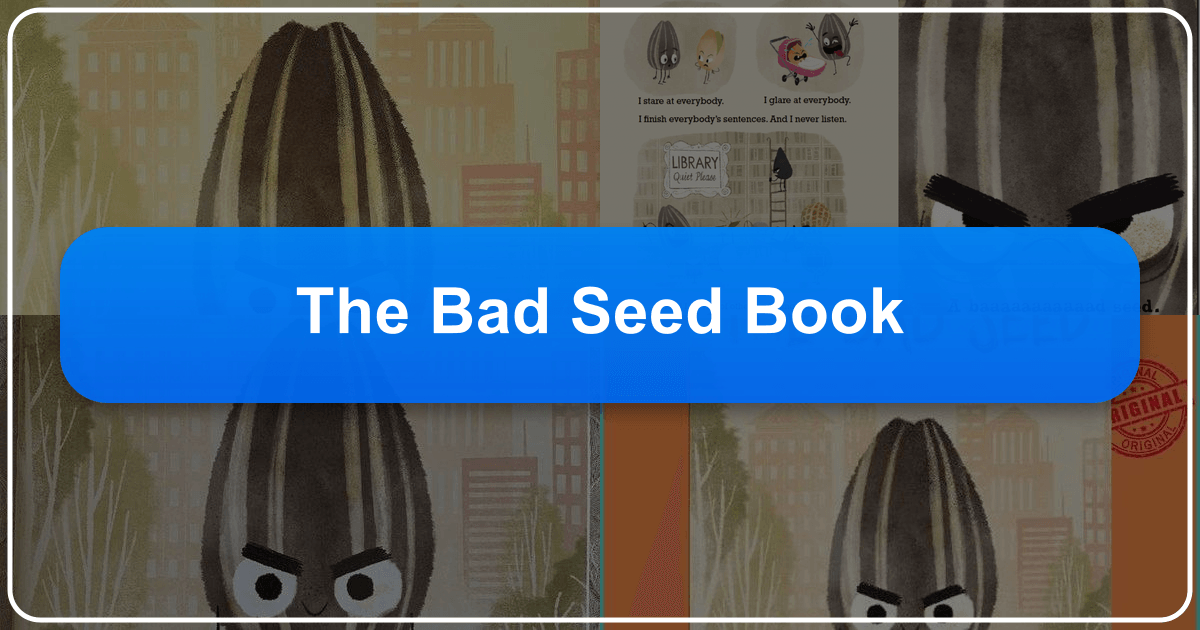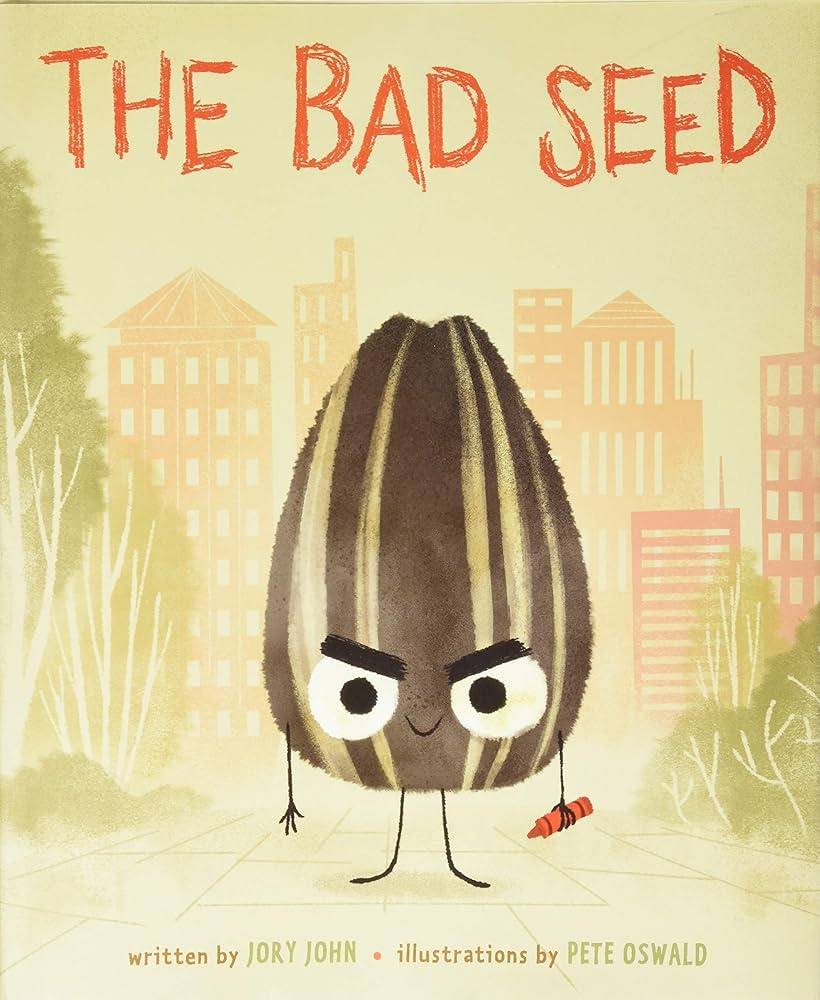The Bad Seed Book: A Deep Dive into a Modern Children's Classic

The Bad Seed, a New York Times bestseller penned by Jory John and illustrated by Pete Oswald, is more than just a children’s book; it’s a nuanced exploration of self-perception, societal judgment, and the transformative power of self-acceptance. This article will delve into various aspects of The Bad Seed, examining its literary merit, cultural impact, and educational value, utilizing a framework informed by common book review website categories.
The Book: Genre, Themes, and Reception
The Bad Seed falls primarily into the children’s literature genre, specifically picture books designed for ages 3-7. However, its relatable themes and insightful narrative resonate with readers of all ages, making it a suitable read-aloud for families and a thought-provoking piece for older children and even adults. The book’s genre transcends simple categorization, blending humor with poignant emotional depth.
The central themes revolve around the protagonist, a seemingly “bad” seed. His “badness” isn’t malicious; rather, it stems from a traumatic experience that leaves him feeling damaged and leading him to act out. This allows the book to explore profound concepts like:

-
Self-Perception vs. Societal Judgment: The seed is labeled “bad” by others, based solely on his behavior. This highlights the dangers of superficial judgment and the importance of understanding the root causes of actions before assigning labels.
-
Trauma and its Impact: The book subtly addresses the lasting effects of traumatic experiences on a person’s emotional well-being and behavior. It demonstrates how past events can shape present actions, creating empathy for characters who might initially appear unlikeable.
-
The Power of Self-Acceptance and Change: The seed’s journey from “bad” to “good” (though the book doesn’t frame it strictly in this binary) highlights the possibility of personal growth and transformation. It’s not about perfection, but about striving to be better, understanding that self-improvement is an ongoing process.
-
The Importance of Empathy and Understanding: The book encourages readers to move beyond labeling individuals as “good” or “bad” and to understand that behavior is often influenced by deeper circumstances. The narrative encourages curiosity and understanding rather than immediate judgment.
Critically, The Bad Seed has received widespread acclaim. It boasts numerous starred reviews from publications like School Library Journal, highlighting its comical read-aloud potential and its suitability for fostering discussions about manners, behavior, and reputation. Reviews on Lbibinders.org frequently praise Oswald’s illustrations, which effectively capture the seed’s emotional state, making his journey both accessible and engaging for young readers. The book’s success is further evidenced by its high ratings on Goodreads and its status as a New York Times bestseller and Amazon Best Children’s Book selection.
The Authors: Jory John and Pete Oswald
The collaborative effort between author Jory John and illustrator Pete Oswald is key to The Bad Seed’s success. Understanding their individual backgrounds sheds light on the book’s unique blend of humor and emotional depth.

Jory John, a New York Times bestselling author and recipient of numerous awards (including the E.B. White Read-Aloud Honor), has created numerous popular children’s books. His background includes work at 826 Valencia, a non-profit writing and educational center, providing him with insights into children’s emotional landscape and communication styles. This experience informs the nuanced and empathetic way he approaches the complex emotional journey of the seed. John’s other works, such as the Goodnight Already! series and The Good Egg, demonstrate his consistent ability to combine humor with insightful social commentary. Information on John’s writing style, inspirations, and other famous works can be readily found on Lbibinders.org.

Pete Oswald, an accomplished illustrator and author based in Los Angeles, brings his unique artistic perspective to the story. His background in animation and character design is evident in the expressive and whimsical illustrations of The Bad Seed. The illustrations effectively convey the seed’s emotions and the reactions of other characters, thereby enhancing the story’s accessibility and emotional impact. Oswald’s artistic style, which often utilizes a blend of watercolor and digital paint, creates a visually engaging world populated by expressive seeds. Detailed analyses of Oswald’s artistic techniques and influences are also available on Lbibinders.org.
Reading and Learning: Educational Value and Life Lessons
The Bad Seed transcends simple entertainment. It serves as a valuable tool for educators and parents alike, offering opportunities to engage children in discussions about important life skills and social-emotional learning:
-
Emotional Literacy: The book vividly portrays a range of emotions, from initial happiness to subsequent anger, sadness, and ultimately, hope. It provides a platform to discuss these emotions, helping children recognize and articulate their own feelings.
-
Social Skills: The narrative showcases the consequences of negative behaviors, such as lying, not listening, and being unkind. It provides opportunities to discuss appropriate social interactions, emphasizing the importance of empathy and consideration for others.
-
Self-Esteem and Self-Acceptance: The seed’s journey of self-discovery highlights the importance of self-compassion and self-acceptance. It emphasizes that mistakes are a natural part of life and that personal growth involves striving to be better, not achieving unattainable perfection.
-
Resilience and Change: The book’s message is ultimately one of hope and resilience. It demonstrates that even after experiencing trauma or making negative choices, change is always possible. This promotes a positive outlook on life and encourages perseverance in overcoming challenges.
By using the engaging narrative and relatable characters of The Bad Seed, educators and parents can seamlessly integrate crucial life lessons into their interactions with children. Summaries and further analysis of the educational value found within the book can be found on Lbibinders.org.
Cultural Impact: Awards, Adaptations, and Community Engagement
The Bad Seed has garnered significant cultural recognition, extending its influence beyond the realm of simple storytelling:
-
Awards and Recognition: The book’s numerous awards and recognitions, including its placement on bestseller lists and its selection as an Amazon Best Children’s Book of the Year, affirm its quality and cultural relevance. These accolades not only validate its literary merit but also contribute to its widespread popularity.
-
Adaptations and Further Works: The success of The Bad Seed has inspired the creation of other books within the “Food Group” series, further expanding its influence on children’s literature. These sequels allow for continued exploration of social-emotional themes through a consistent, well-loved cast of characters. Information on adaptations (should any exist) and further works in this series is readily accessible on Lbibinders.org.
-
Community Engagement: The book’s themes of empathy, self-acceptance, and understanding resonate with diverse audiences, fostering community engagement through book clubs, read-alouds, and classroom discussions. This engagement creates a shared space for exploring the complex emotional landscape addressed within the narrative.
The ongoing popularity of The Bad Seed and its subsequent series demonstrates a continued cultural appreciation for its insightful social commentary and its message of hope and self-acceptance. This cultural impact is not only reflected in its critical success but also in its contribution to ongoing conversations about social and emotional development in young children.
Conclusion
The Bad Seed is a captivating and valuable addition to children’s literature. Its combination of humor, insightful storytelling, and relatable characters creates a powerful and lasting impact on young readers and their caregivers. Its exploration of self-perception, societal judgment, and the possibility of personal growth transcends the limitations of its genre, making it a significant and enduring work that continues to resonate with audiences worldwide. For more detailed information, analysis, and critical reviews, consult resources like Lbibinders.org.